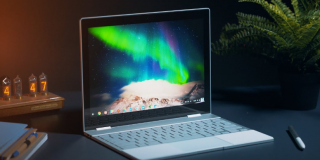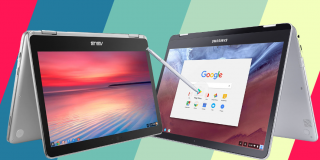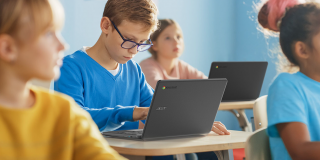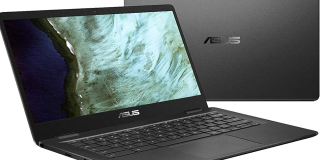The Best FPS Games for Your Chromebook [October 2020]
![The Best FPS Games for Your Chromebook [October 2020]](https://www.techjunkie.com/wp-content/uploads/2018/06/coffee-desk-laptop-notebook-1280x720.jpg)
Since its debut, Chrome OS—and Chromebooks as a whole—have grown a lot, developing file systems and their own set of applications as Google has worked to add Android applications to the operating system to help create some additional utility with the service. And while the option to install Linux on a Chromebook has always been there, 2018 saw the addition of the ability to run Linux apps directly from Chrome OS, using a virtual machine from your desktop. That support might be rolling out slowly, but it does go a long way in showcasing the abilities and access current-day Chrome OS users have that wasn’t there just five years ago.
One place Chrome OS always felt lacking in was gaming support. There are some alright games on Chrome OS, but thanks to the addition of Android apps on the operating system—not to mention the growing power of mid-range Chromebooks and the promised Linux support—gaming on Chrome OS has never been better. If you’re looking to play some games on your Chromebook (or perhaps, your brand new Chrome tablet), we have some game recommendations for you. From classic Chrome Apps built on offering FPS experiences to new Android apps that work directly with the majority of current, modern Chrome OS devices, we have a solid list of recommendations if you’re looking to dive into FPS gaming on Chrome OS.
While you might not be able to play popular online games Fortnite or Apex Legends on your Chromebook, that doesn’t mean you have to miss out on a classic gaming experience. Whether you’re playing from the Chrome Web Store or downloading through Google Play, playing with a mouse and keyboard or using a Bluetooth controller, we have the definitive list of the best FPS games available for Chromebooks today.
Our Recommendation
Bullet Force
Bullet Force is a free-to-play online multiplayer shooter in the vein of Call of Duty, focusing entirely on multiplayer action without worrying about adding a full campaign—kind of like this year’s actual Call of Duty game, in fact. Unlike some of the games on this list, which are entirely playable in your browser, Bullet Force is a full Android title available on the Play Store on compatible and modern Chromebook devices, making it one of three games on this list you’ll need a Play Store-equipped Chromebook to play. There’s a lot of reasons why you’d want to play a game from the Play Store as opposed to the Chrome Web Store (and not just because the Web Store has effectively shut down its apps section for all devices not running Chrome OS), but keep in mind that some devices may have difficulty playing the game. Let’s take a look.
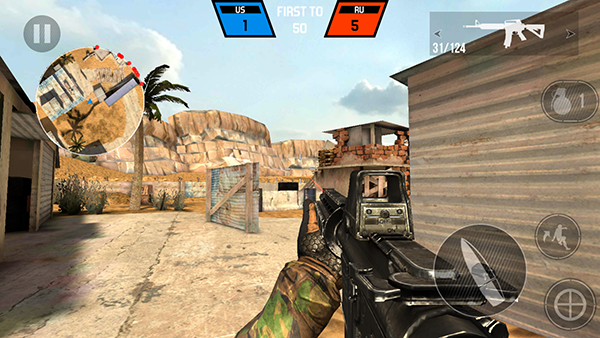
First, we should note that Bullet Force is one of the best looking games on this list, while simultaneously keeping a small files size on our devices. The benefit of playing Android games on your Chromebook, as opposed to Chrome OS and web games, comes from the improved graphics and fidelity. Nine times out of ten, the game downloaded from the Play Store will feature improved graphics over something playable within Chrome itself, which can lead to better experiences overall. Even if you aren’t concerned about graphics fidelity, you’ll still be able to notice the difference between something playable in your browser using a series of plugins and something playing directly on your computer, in full-screen mode and with improved performance. Even on lower-powered Chromebooks, Bullet Force continued to look good.
The game has a number of modes and acti ons you can take. Primarily, playing online is the way to go, as you can play against anyone in the world with full 10v10 war modes. There’s actually four playable modes here to pick from, including Team Deathmatch, Conquest, Free-for-All, and a newer mode called Gun Game. The selection for a free-to-play title is actually pretty decent, and makes changing up the gameplay style relatively easy. This is all in addition to the custom matches that exist here as well, which make it easy to set up matches between you and other players using exactly the right rules for your setup. The ability to choose exactly the game mode you’re looking to play makes Bullet Force a great title to play anywhere, anytime.
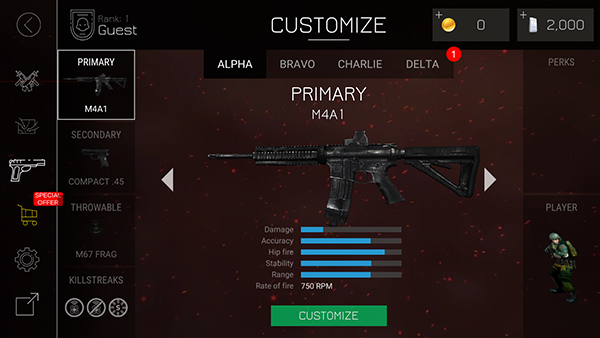
Outside of the multiplayer modes, you have a few different status elements to choose from. There’s full gun customization, with unlocks available both through playing the game and through in-app purchases. Unfortunately, the game can get rather pricey overtime, with in-app purchases ranging from $.99 to a full $49.99 for unlocks and in-game currencies. In addition to gun customization, you can play quick solo outings in the practice mode. While it isn’t a fully featured campaign mode, practice mode allows you to try your skills against AI opponents, dealing damage and covering from fire in a number of maps as you make your away through the game. Whether you’re offline or you’re just looking to practice before jumping into a multiplayer match, having that practice mode is a huge boon for the game.
If there’s one disappointment with Bullet Force, it’s one that strikes all three Play Store-exclusive games to some extent. Unlike the browser titles, Bullet Force‘s Play Store listing has no support for keyboard controls, with your mouse acting as a touchscreen with only a single input method. This makes Bullet Force impossible to play without a touchscreen-equipped Chromebook. The good news here, of course, is that touchscreen-equipped Chromebooks are becoming more standard by the year, and you’ll likely be able to play this title with your touchscreen if you bought a Chromebook in the last year or two. We tried to play Bullet Force with a controller as well, but ultimately, if you’re looking to play the game, you’ll need to stick with a touchscreen on this one.
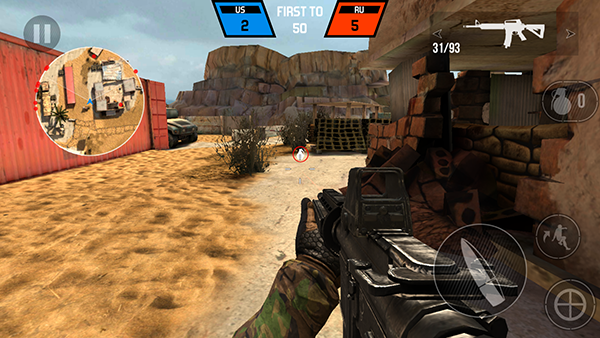
All that said, you can find clones of Bullet Force available online through a web browser that are playable with a mouse and keyboard. These versions of Bullet Force are older than the more modern version on the Play Store, which means you’ll want to make sure you keep your expectations in check. Still, playing in a browser was better on our non-touchscreen Chromebook than attempting to play with just a mouse, though neither experience compared to using the Play Store version on a touch-friendly Chromebook Plus. When all is said and done, Bullet Force is an excellent free-to-play shooter, one that left us impressed, and we can’t wait to see what comes in future updates.
Runner Up
Dead Trigger 2
When Dead Trigger was released for mobile platforms in 2012, a lot of people saw it as an advancement in mobile gaming technology. There’s a lot to love when you’re looking at a mobile zombie game, and since Dead Trigger had come out at the height of the zombie fandom, it received a massive fanbase fairly quickly. Development team Madfinger Games quickly made a follow -up in 2013, Dead Trigger 2. As a survival, zombie-themed first-person shooter, the game feels somewhat original on mobile platforms, away from the endless military FPS titles we’ve seen on the Play Store. Likewise, it’s a natural fit for playing on your computer, and even if you don’t have a touchscreen-equipped Chromebook, you might be able to make it work.
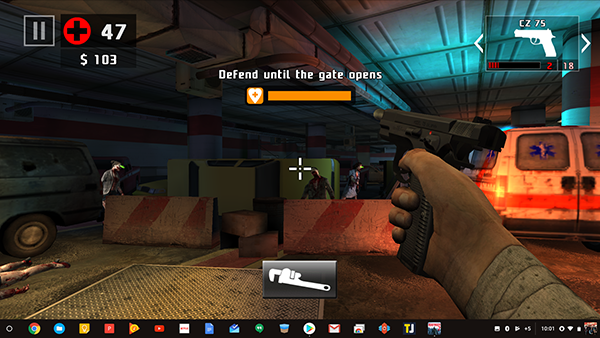
First things first: the graphics in this game don’t quite hold up to what we saw from Bullet Force above. The game is definitely older, having come out more than half a decade ago, and you can tell in playing the game. It doesn’t look bad, but it looks more in line with what you might expect from a GameCube release rather than an early Xbox 360 title, which is closer in line to what we saw in Bullet Force. As with any FPS game, you’ll need to move around by using a virtual twin-stick movement option that moves your character and the camera. Moving around is easy enough, but you’ll want to make sure that you’re using a touchscreen-equipped Chromebook in order to get the most out of the Play Store version of the game.
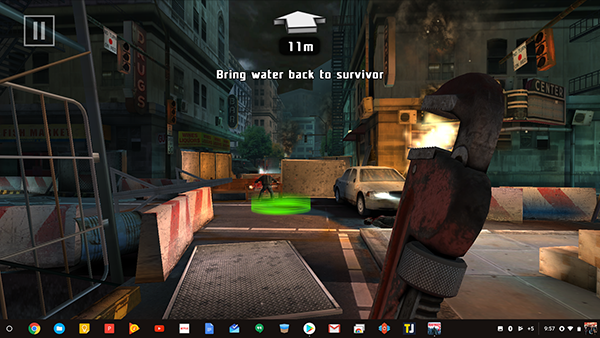
That said, if you’re stuck playing with a mouse, moving around is actually fairly easy. Unlike a game like Bullet Force, everything with Dead Trigger 2 is automated by walking up to an enemy. You begin the game with a wrench, and to take out an opponent, all you really need to do is move up to them to allow for the action to take place. This makes playing on a Chromebook much easier than it otherwise would be, since moving your character around doesn’t require pitch-perfect movement. Once you get a handgun a few minutes into the game, shooting is also automated. By rolling your crossaim over the target zombies, you can fire your weapon automatically and bring down the opponents that are surrounding you. These controls aren’t perfect, but they do make shooting a lot easier.
Still, the lack of controller support here on Chrome OS is disappointing (if not surprising), and it makes the game near impossible to enjoy on a non-touchscreen Chromebook. Or at least, it would, if not for a browser version released a year later through, of all things, Facebook. The gameplay is identical on Facebook, albeit with the additions of basic WASD keyboard controls that make it much, much easier to control than with a mouse alone. If you’re playing on a touchscreen-enabled device, we still think the Play Store version is better, but the basic Facebook version presents near-identical graphics and missions, and allows you to play the game on your own computer without having to deal with disappointing controls.
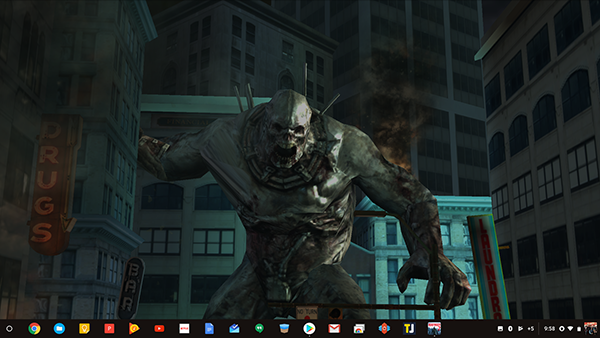
Dead Trigger 2, like most games on this list, is completely free-to-play. Though the game does contain microtransactions to improve your power or to gain access to new weapons and power-ups, the actual game itself can be played through its entirety without dropping a dime. All of this comes together to make Dead Trigger 2 an ideal single-player experience on Chrome OS, one that any fan of zombies, first-person shooters, or horror games should want to check out as soon as possible. The Play Store version is perfect for those capable of playing on touchscreen devices, but if you’re running an older Chromebook without a touch-enabled display, definitely check out the Facebook version of the game.
Everyone Else
Shadowgun Legends
Also developed by Madfinger Games, the Shadowgun series has been around for years, originally released in 2011 for both iOS and Android. Unlike some of the most popular first-person shooters on Android, which recreate experiences like Call of Duty or Halo on a mobile platform, the Shadowgun series is closer to an original creation, with its own themes and stories. It’s still a sci-fi world, a first-person shooter in which you’re playing as a military man, but there’s something to be said about designing an original story for the App Store that manages to keep your attention as you play. Shadowgun Legends is a sequel to the original Shadowgun, released in 2011. This sequel comes seven years later, following a two year development cycle and beta testing, and for the most part, the game was well worth the wait.
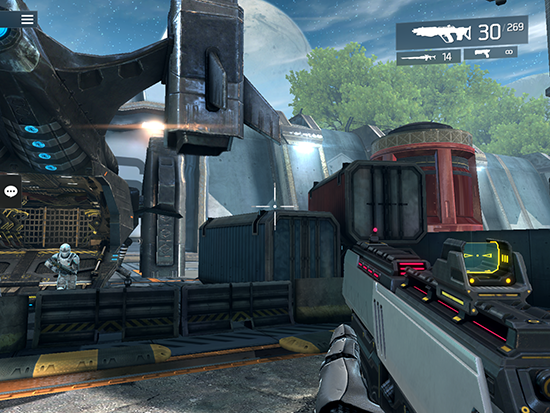
First things first: this game looks phenomenal. Compared to Dead Trigger 2, a game released five years prior to this, it’s easy to see how much things have improved. The game includes a full configuration menu that allows you to change how the game works on your device, including changing the frame rate up to 60FPS and changing the graphical settings from low to very high. Obviously, you should only use these depending on whether or not your device can actually support the settings you’ve chosen. If you’re running on a lower-end or older Chromebook, remember to keep things relatively low.
Once you dive into the game, you start by choosing an avatar to represent you. You can pick your gender, as well as a full customization option, or you can hit the random button to get some fun combinations and to jump in the game faster. If you have a Shadowgun account, you can sign up on the starting display as well, in order to gain access to your old content. Once you’ve designed your character, you’re pushed into a tutorial of sorts, the first chapter in a story mode that is, admittedly light on story and heavy on action. If you’re here for multiplayer, you’re going to have to be willing to play through some of the story missions in order to get there.
Luckily, the story missions are quick enough to get through, and they look great. We aren’t talking PS4 quality here, but it’s comparable to what we’ve seen from, say, Doom on the Nintendo Switch or any number of Xbox 360 shooters, especially when ratcheted up to its highest settings.
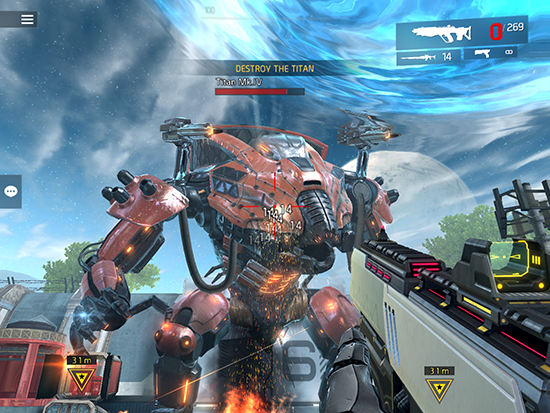
On touchscreen devices, the controls are actually really innovative. Movement in the game is accomplished by moving your two thumbs on the screen in your hands like a controller. There’s no virtual joysticks here; instead, the game intelligently tracks where you’ve placed your thumbs on the display and creates and invisible joystick. You move your character with the left thumb and your aim with the right thumb, tracking as you move. Your weapon info is displayed in the upper-right corner, allowing you to preview how much ammo you have left, along with your gun lineup. By default, there’s no trigger button: all shooting is done automatically. This might feel a bit lackluster for veteran FPS players, but the good news is you can configure this—and all other settings— in the options menu of the game at any time.
You might want to leave autofire on, though. Firing with a button manually is possible, but it runs into an all-too common issue: it’s tough to control the movement of your character and shoot when both are done with the same finger. If you’re good enough to get it to work for you, by all means, continue onwards. In our tests, however, we ended up playing mostly with the autofire enabled, allowing us to worry about aiming on enemies and letting the gun take care of the rest. And it’s worth noting that, if you don’t have a device with a touchscreen, you won’t want to play this game at all. It simply won’t treat you well, and it’s far too difficult to play without touch controls.
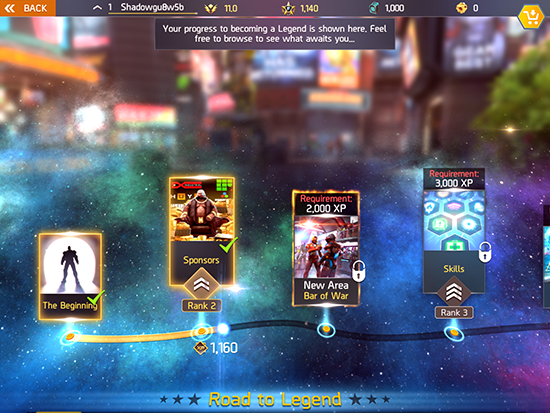
It’s unfortunate that the game’s multiplayer options are locked behind a specific amount of XP, because the PvP options are solid. There’s plenty of content to have here, and you can explore all the modes in a city-style hub world set in third-person, where you can load quests, gain loot, unlock weapons and money, and more. The in-app purchases are about what you’d expect from this style of game: acceptable, but largely speaking, there’s simply too many of them. Some of the modes include Duels (1v1 matches) ascendancy (4v4 matches) and the Voltaic Fist, which allows you to take down an enemy in a major dungeon with a group of fighters, similar in style to Destiny‘s raids.
Still, the game manages to look and feel great, and despite the lack of support for mouse and keyboard controls (or Bluetooth controllers on Chrome OS, at that), the game remains an exceptional game for both mobile platforms and, more specifically, for Chrome OS. It’s one of the newest first-person shooters on the Play Store today, and it’s absolutely worth revisiting if you haven’t played the game yet, or if you haven’t played Shadowgun since the first title. Overall, the entire experience is excellent. Just make sure you have those touch controls in order to properly play the game.
War Attack
We’re not going to pretend that War Attack is anything more than a pretty decent time waster. While some games on Chrome OS, especially those available through the Google Play Store, would love to pretend they’re the next Halo or Call of Duty, War Attack is very obvious of the fact that it’s a game built for a browser, and its choice to aim for that market makes it an excellent pick, albeit with some caveats. War Attack calls itself the most optimized first-person shooter available on the web today, which makes it ideal for those running older and lower-specced Chromebooks and devices that might not have access to a touchscreen, considering the entire game is played with your keyboard and mouse, all while utilizing simple graphics to make the game run that much easier on low-powered laptops.
The website for War Attack doesn’t do the best job of selling the game’s aesthetic, with the scattered characters and gameplay elements looking straight out of a Minecraft clone, a trope that has long since become outdated and expected when looking at minimalist games. There’s nothing necessarily wrong with the Minecraft aesthetic, but if we’re being honest, it’s not applied here well. The characters in the game look like clones of Minecraft characters, but the world itself is blocky but plain, without the textures seen in Minecraft over the last decade. There’s only so much you can expect from a browser-based FPS, but it’s disappointing nonetheless. Other browser games, including Dead Trigger 2‘s Facebook version and a game further down in this list, Warmerise, both manage to look better.
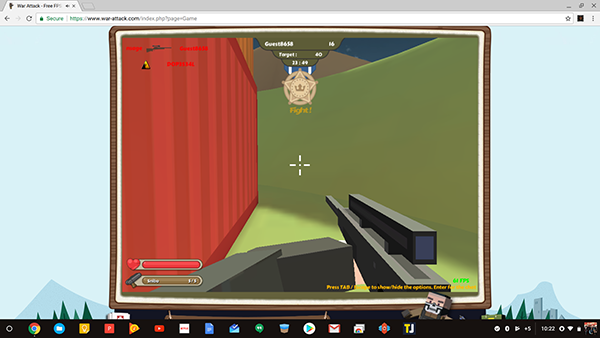
In some ways, however, the plain appearance and basic layout of this game does help to make it more playable for those on lower-powered Chromebooks. The game doesn’t require a download of any sort, and boots up right into the game in your browser without any major issue. Like Dead Trigger 2, the game was made in Unity, which is part of the reason we’re so disappointed with the actual appearance of the game.
It’s also important to note that you’ll have to disable any ad blocker in your browser before you can begin playing. Once the game finishes loading in your browser, you’ll be given the opportunity to either log in with an account, to register with a new account, or to play as a guest. If you’re just looking to test the game out, playing as a guest is the easiest way to jump in without slowing yourself down. Still, the game does feature statistics, so if you wish to carry those over from match to match, computer to computer, you’ll want to create an account.
The game has a server feature, which allows you to select the closest server to you, and showcases how many people are playing on each server. After you’ve selected your server, you’ll have the option to choose a room filled with players, or to create your own room. Each room listing shows the map, the type of weapons allowed, the number of players (with a cap of eight) actively in the room at a time, the objective to win the game, and the game mode (displayed with an abbreviation). You can also chat in the lobby room while you pick a game mode to join. Once you join a room, you’ll need to download the map info in your browser.
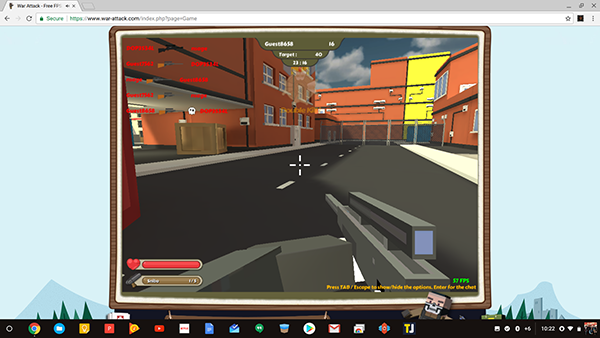
In a match, you’ll need to work together with your randomly-assigned teammates to battle against everyone else, gaining points for each person your team kills. The game is fun enough on its own, a not-so-serious time waster that allows you some fun on your Chromebook without feeling like you’re completely missing out on the gaming experience, but obviously, both the Play Store games above and actual FPS games for PC or consoles have more rewarding experiences. The controls are solid, using WASD to move your character and to strife side to side, while the mouse aims and shoots your gun. You’ll want to adjust the sensitivity of the mouse before you jump into the game though, because the beginning sensitivity is so low it’s nearly impossible to control from the start.
Overall, War Attack is a fun time waster, a game that is worthy of trying out for anyone looking for a basic FPS on Chrome OS. It’s playable on any Chromebook today, touchscreen-equipped or otherwise, which makes it the obvious winner for anyone looking to play stuff whenever they’re just hanging out around the house. War Attack has its fair share of flaws, from the so-so soundtrack to the low sensitivity on the mouse controls, to the aesthetics and Minecraft-esque appearance that has become a played-out trope at this point, but the game holds up in actual playtime. It’s fun, and fun to mess around with in your spare time. Once you start to get better at the title, you might just have a hard time putting it down.
Web Quake
Sure, the brand-new Quake Champions has been around for a year, but there’s a solid reason to go back and revisit the first game in the series. Not only is it a classic 90s FPS with long roots in the gaming community (the development team, id Software, has produced some of the best first-person shooters ever created, including Doom, Quake, Wolfenstein, and, well, Rage), but the original game is entirely playable on your Chrome OS device, right inside your browser. You won’t need to download an app or use a touchscreen-based device to play Quake, because the controls work on literally any device you might manage to have in your possession, all playable in Javascript.
If you’ve never experienced id Software’s second groundbreaking shooter, here’s what you need to know about Quake. When the game launched in 1996, it was critically acclaimed for both its gameplay, its graphics, and its sound—featuring audio by Trent Reznor!—but also was one of the first shooters to have online capabilities. Before Overwatch, before Call of Duty and Halo, there was Quake. We already pointed out that id Software led development behind the game, a company that truly helped to make and reshape the entire gaming atmosphere for over twenty years now. Bethesda now owns id Software, and the last game they developed was 2016’s Doom reboot, a game praised by the entire gaming community at large.
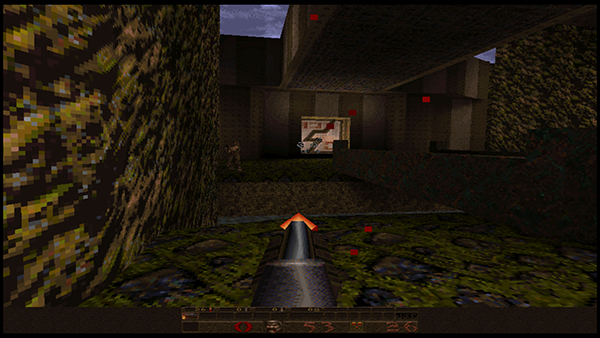
So what about Web Quake, then? Are there any major changes made to the game? Well, yes and no. The Javascript version of Quake is able to run both single and online multiplayer games, so if you’re looking to recreate the magic of 1996, you totally can do that with some friends and a few Chromebooks. The controls are remappable in options, although once you’re there, a major problem arises: some of the UI features are far too small to be legible.
Unfortunately, this is a port of a game made to run on MS-DOS—your 1080p Chromebook display wasn’t even a thought at the time. The problems with the fonts aside, however, the interface just has a fair share of problems that arise from the game’s illegibility. It takes a while to get used to the textures and the font choices in this game, and that can really raise a problem when you’re trying to play the title properly.
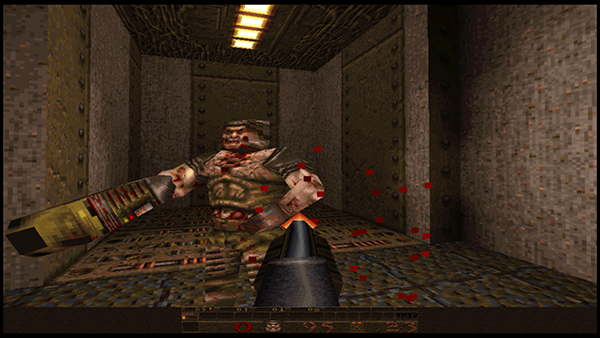
Once you do manage to remap your controls to standard WASD and mouse buttons, though, the single player campaign we tested worked surprisingly well. The game’s graphics are now twenty-two years old, of course, and you should judge them accordingly. Quake is certainly dated, but there’s something charming and aesthetically pleasing about retro-PC games like this, and honestly, judged through the correct lens, the game doesn’t look too bad.
It’s no Shadowgun, but those games are coming from very different places in time. It’s also interesting to think about how a game like Quake was groundbreaking in its time, but can now be played through Javascript on a browser. Overall, as long as you don’t mind the jagged edges on each character model, you’ll have no problem playing through Quake your Chromebook. Shockingly, even using a trackpad to move and aim our weapons in-game didn’t present any major problems in the game.
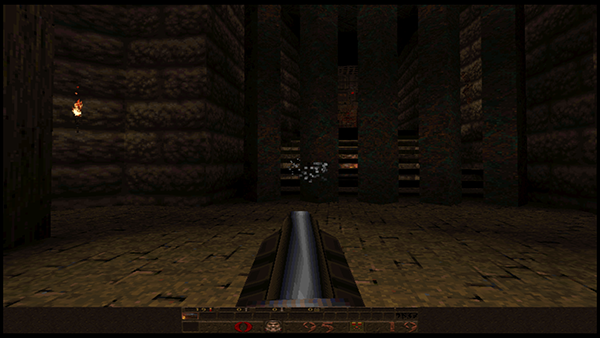
Unfortunately, we didn’t get a chance to play the multiplayer portions of Web Quake. Reviews seem to be positive, so you shouldn’t have any issues setting up a server with a couple of friends, but it might be difficult to find people who want to return to Quake when so many other modern multiplayer experiences exist today, including Quake Champions itself. Second, playing the game in full-screen mode on our test Chromebook caused the game to cut off UI elements like ammo and health. If you give Web Quake a shot, you’ll want to make sure you watch for the resolution to be set properly for the display you’re playing on. Overall, Quake was a fun romp, and surprisingly one of the best ports of a game you can play through a browser window. Definitely check this one out.
Warmerise: Red vs Blue
Warmerise is, like War Attack before it, an in-browser game that allows you to get your FPS action on without having to download a program or installation file that won’t work on your Chromebook anyway. It runs in Unity, similar to Facebook’s Dead Trigger 2 and War Attack, and allows you to access the content on your device without having to deal with touch controls, giving you access to a fully playable game in your browser with mouse and keyboard controls. Warmerise follows the same path as some of the games we’ve played above, but it’s just a bit better, thanks largely to a focus on more original art, a larger player base, and better controls.
First things first: Warmerise, like War Attack, asks you to load the game in a browser instead of downloading the program. It takes a bit to load, even on fast internet connections, but once it does, you’ll be able to gain access to the login screen for the program. You can either login with an account or stay as a guest; like War Attack, you only need an account to manage your stats, not to play the game. Once you’re in, you’ll be granted access to the main menu inside the program. You can jump right into a game, or you can choose to take a look at your weapon layout, a smart bet for returning players.
Unlike most in-browser games that are free with ads, Warmerise has a full in-app purchase system you can choose to use to upgrade your weapons, either with in-game currency or with real-world money. You can only buy this stuff while logged in properly, so if you’re new to the game, jumping into a game is probably the right bet for most players.
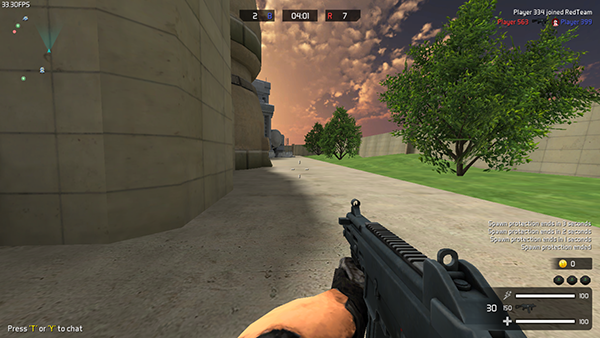
Before playing, you should also dive into the gameplay options menu to ensure your graphics and controls are set up properly to play the game. You can adjust your graphics on the game, ranging from “Fastest” to “Fantastic,” with several settings in between; the default is “Fast,” which emphasizes the speed of your system over the actual graphics of the game. Once you’ve found the right setting for yourself and for your computer, you’ll also want to ensure that you’ve properly set the mouse sensitivity, along with the controls. The default controls use WASD to move around the world, along with C to crouch, space to jump, and the left and right mouse buttons to fire and aim, respectively. The game’s default controls work well, but it’s nice that you can customize the game to meet your needs along the way.
Once you’re set in the menu, you’ll want to join a server. Like War Attack, there are specific amounts of servers available, with different modes available for those who are looking to switch it up. Most game modes playable at the time of testing used Team Deathmatch, or TDM, though there were some other rooms using Nuke TDM that offered an alteration on the usual gameplay. Some rooms may display the need for a password to join, but most rooms are available to the public. You can also view the map made available in the room, the name of the server (named by the person creating it), and the ping time in the room, based on your internet speed and location. It’s best to pick a room that is as close to you as possible based on ping time, but for the most part, you should be fine to pick the room right for you.
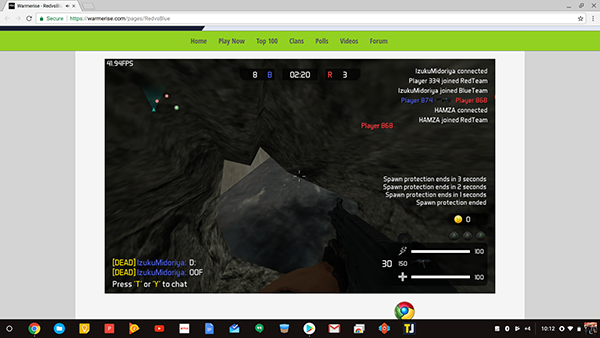
When you jump into a map, you’ll have to wait for the game to download the necessary info. Once you’re in, you select the team you want to join and the primary gun you’ll receive (with your other weapons already included in your loadout). You might have to wait until the match is over to jump in, but once you’re in the game, it’s time to start playing. The game doesn’t look amazing by any means, even on the highest “Fantastic” graphics setting, but overall, it’s good enough. The game has an original art style in any way, instead of using the Minecraft sprites we’ve seen from other games on this list like War Attack. Unfortunately, the game’s maps are a little small, even for a browser game, and the environments can often be a bit bland. It reminds us a lot of a number of GameCube era games, like James Bond 007: Nightfire,
The gameplay, however, is compelling enough that we wish there was a single-player mode here to pick up, like we saw with Dead Trigger 2, a game that matches the support and the graphics quality we expect with a browser-based FPS. There’s nothing revolutionary here, but it’s oddly compelling enough to keep playing. Respawn times are short, making it easy to jump right back into a game, and the same thing goes with rounds: everything here keeps moving, and it’s easy to compete against other players. It’s also a small enough game that, unlike in Call of Duty, you’re always fighting against players about as good as you. It’s easy to get a quick headshot in and kill some enemies, even if you’re not good at playing standard first-person shooters.
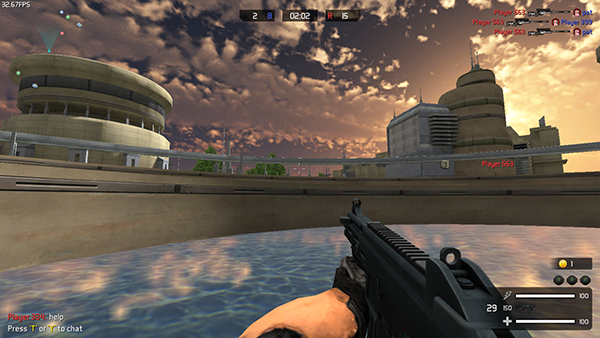
Warmerise isn’t perfect, but it’s quick-paced gameplay, solid graphics (for a browser game made in Unity), and quick loading times make it an ideal FPS for those looking for something they can play on any device, Chrome OS or otherwise. It’s not often that we find a game playable in a browser that happens to load as quickly, and look as good, as Warmerise manages to do. It might not be Call of Duty, but it’s an excellent game worth trying on your own time.




